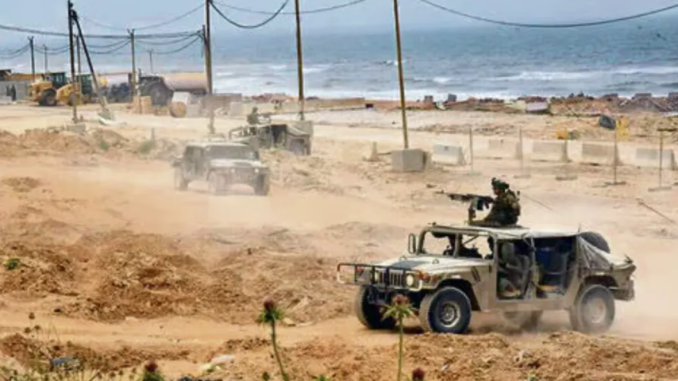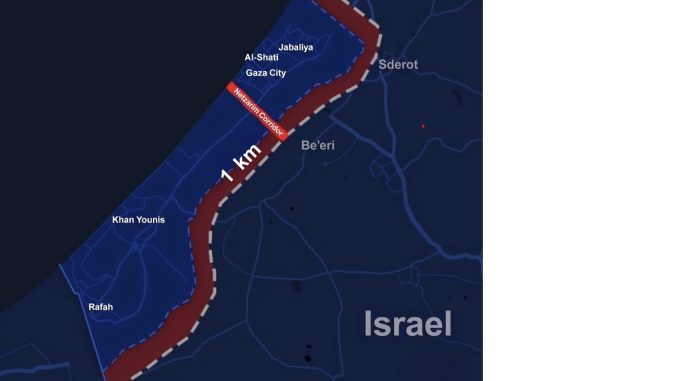Peloni: Israel should maintain permanent security presence over all of Gaza and should also take the northern half or third of Gaza for Jewish settlement. The only penalty which the Arabs recognize as penalizing is the loss of territory, and they must understand that the purposeful mutilation, slaughter, rape and kidnapping of Israeli citizens, as took place on October 7, will have penalizing effects.
Former reserve officer says plan is for limited military rule – ‘I don’t think Israel should live in Gaza’
 Israeli soldiers patrolling along the Netzarim Corridor (Photo: IDF)
Israeli soldiers patrolling along the Netzarim Corridor (Photo: IDF)
Reports in Hebrew news media indicate that the IDF is preparing for a long-term presence in the Gaza Strip, even after the end of the war.
The IDF has built up its presence and control of several key points in the Strip over the past few months in what analysts say is a preparation for a long-term military presence in the enclave after fighting has ended.
This buildup is most clearly seen in one of the most critical areas for the IDF’s ground operations in Gaza, the Netzarim Corridor.
The Netzarim Corridor divides the Gaza Strip in half, running for approximately 8 kilometers (5 miles) from Kibbutz Beeri until the Mediterranean Sea. The IDF took control of the Netzarim Corridor early on in the war, as it attempted to divide Hamas forces in Gaza, and to control the flow of the civilian population in the Strip during the war.
 Map of Gaza marking the Netzarim Corridor (Image: ALL ISRAEL NEWS)
Map of Gaza marking the Netzarim Corridor (Image: ALL ISRAEL NEWS)
Several months ago, the military increased its presence in the corridor as part of a strategy to use its presence there as a bargaining chip in the hostage negotiations. The thinking was that Israel would offer to withdraw from the critical area in return for the release of 100 hostages by Hamas.
While that strategy never played out, due to Hamas hardening its positions in the negotiations, especially following the killing of several key leaders, such as Mohammed Deif, Ismail Haniyeh, and Yahya Sinwar, the IDF has begun to expand and develop its presence in the corridor, recognizing its key location as a way of enforcing security in the Gaza Strip.
On November 4, Channel 14 military correspondent Hillel Biton Rosen told the hosts of the “Israel Morning” program, “We are here to stay, to control security.”
Rosen pointed to several key developments, most significantly, expanding Israeli control of the Netzarim Corridor from the narrow road which crossed the territory from East to West, to an almost 7-kilometer-wide swath, North-to-South.
“All in all, we’re really talking about a tremendous distance,” Rosen stated. He also indicated that he believes the IDF is taking this step in the absence of a reliable authority to govern Gaza.
The Strip is only 41 kilometers (25 miles) from its northern to southern borders. The clearing of a 7-kilometer path, with reports indicating that most buildings and infrastructure have been leveled in that area, indicates the IDF’s desire for freedom of movement in the area. The cleared area represents a total area of about 56 square kilometers (22 square miles).
This development is in addition to the IDF clearing a 1-kilometer zone along the existing border, as well as the clearing of the area around the Philadelphi Corridor which runs along the southern border with Egypt.
Reports indicate that the military has posted Israeli flags along the road running across the corridor, as well as installing electricity and water lines, and even cell phone towers point to a real possibility that the IDF is planning to keep soldiers here long-term.
One base along the corridor, called Crossing 96, has an IDF base, with facilities made of modular container units. There soldiers monitor and control traffic both into the Gaza Strip, and across the Netzarim Corridor. The facilities include air conditioned sleeping quarters, a mess hall, a command and control post, and even bathroom facilities with showers.
Israeli analysts have said this build up of forces and infrastructure could also be intended to add pressure to the hostage negotiations. As the IDF continues to destroy Hamas fighters and infrastructure in areas like Jabaliya, while also pushing for all civilians to flee south of the Netzarim Corridor to the al-Muwasi Humanitarian Zone, it can threaten Hamas with annexation of some or all of the northern Gaza Strip unless it releases the hostages.
A report in Ynet News indicated that IDF outposts were built using the modular containers to allow for easy moving of the outposts to a different position if needed by tactical demands or changes in the negotiations. At any rate, the outposts are still clearly temporary affairs, not contracted with concrete and other permanent materials.
Danny van Beuren, a former chief reserve officer, told Channel 14’s “Israel Morning” program that the military is planning for limited military rule at this point, saying, “I don’t think the State of Israel should live in Gaza.”



RAPHAEL-
Yes, there were 2.3-4 mill….according to Gazan figures, but not according to Israel’s.
The true figures WERE about 1.3 mill, but that was years ago and much emigration has happened since then.
I don’t care a scrap how crowded they are or will be. Right now the most of them are squeezed into south Gaza and managjng……100% would
emigrate if given the chance NOT 50%.
Israel spent umpteen billions to create a cutting edge wal.fenceto about 20-30 metres underground to eliminate tunnels an they still found it easy to gt into Isrel.Nobody even mentions this enormous waste today.
So it would be a porous top seurity prison at best.
Edgar –
Yes, the Gazans should go. Some will, but most won’t. Weren’t there 2M of them? Even if half of them left that would still leave 1M, which is way too many. So Israel will be forced to turn Gaza in to a combination pre-school, insane asylum and maximum security prison. In the meantime, maybe Israeli scientists can discover something which will turn them back into human beings.
Adam-
The Gazans may say that now, but I wouldn’t believe an Arab if he stood on his head and swore by Mohammed. They have a built in gene which dictates their congenital lying .
The old joke about Arab propensity to lie and believe it’s truth is told in the old joke
The Arab was dozing, and disturbed by kids playing nearby. So he called them over and told them that free apples were to be had at the far end of the village. whereupon they all scarpered to get them.
Te Arab settled back comfortably to doze again. Suddenly he sat up and said, “free apples, I’d better get over there quick and get my share before they’re all gone”…. .
Raphael-
As to where the Gazans would go, they would crowd into the southern portion as they are right now. If they find that “uncomfortable” they can emigrate as many o each year. The land belongs to Israel legally anyway.
Most of the Gazans are Egyptians.
It has been suggested that Israel should retain the upper 1/3 to 1/2 of Gaza, because the loss of land may actually have an effect on the Arabs. Well, that’s a plan, and maybe there are some advantages to it.
But as an Israeli diplomat once said to me, “… what are you going to do with “them?” If Israel starts annexing back chunks of Gaza, where are the Gazans going to go? And, if Israel allows Jewish settlements back into Gaza, will the palestinians co-exist peacefully? Unlikely. So, that’s one issue.
A larger concern, I think, is that it would be very ill-advised to (ever) allow Gazans to move back to the Rafah area (except sparsely), and especially to the Philadelphia corridor in particular. There must be an empty buffer controlled by the military, so that smuggling tunnels and terror tunnels don’t reappear.
Should the rest of Gaza be open for Israeli civilian settlement? I would judge that to be a high risk endeavour, so most, if not all, of Gaza should be under military “supervision”.
I see maps now showing Gaza divided into five parts: Jabalia, Gaza City, Deir al-Balah, Khan Younis, and Rafah. Perhaps each district should be physically separated from each other and governed independently by Israel. Israel could loosen its grip on each district, based on the success of passification efforts. Eventually Gaza could become prosperous and peaceful, again, once Hamas and its ideology is eliminated and replaced with something better.
IDF reveals footage of Hamas torturing Palestinians in Gaza (Warning: graphic content)
The footage, which spans thousands of hours, was reportedly obtained from surveillance cameras installed between 2018 and 2020
i24NEWS
i24NEWS
3 min read
November 10, 2024 at 06:36 AM???latest revision November 10, 2024 at 10:07 AM
Terroristes du Hamas
‘May the Jews kill them’ | Watch: What Gazans think about Hamas after a year of war
Channel 12 News reporter Ohad Hemo spoke to Gazans and was surprised to learn what they really think about Hamas after a year of war: ‘I was glad when you killed Sinwar, who destroyed and killed our children’
Israel National News
Israel National News
Nov 10, 2024, 7:05 PM (GMT+2)